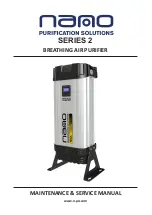
3. INSTALLATION (
CONT
’
D
)
3.6 C
ONNECTING
THE
DUCTS
TO
THE
U
NIT
11
CAUTION
If ducts have to go through an unconditioned space (e.g.: attic), always use insulated ducts.
CAUTION
Make sure the vapor barrier on the insulated ducts does not tear during installation to avoid condensation within
the ducts.
I
NSULATED
FLEXIBLE
DUCTS
Use the following procedure for connecting the insulated flexible duct to the ports on the unit (exhaust to outside and fresh air from
outside).
Pull back the insulation to expose the flexible duct and place it
over inner port ring
.
Install good quality
aluminum duct tape
on flexible duct to prevent potential water leakage from duct.
Attach the flexible duct to the port using tie wrap.
Pull the insulation over the joint and tuck it
between the inner and outer rings
of the double collar.
Pull down the vapor barrier (shaded part in illustrations below)
over the outer ring
to cover it completely. Fasten in place the vapor
barrier using the port strap (included in unit parts bag). To do so, insert one collar pin through vapor barrier and first strap hole,
then insert the other collar pin through vapor barrier and center strap hole and close the loop by inserting the first collar pin in the
last strap hole.
CAUTION
Do not use screws to connect rigid ducts to the ports.
R
IGID
DUCTS
To prevent potential water leakage from ducts, use good quality aluminum duct tape to connect the rigid ducts to the ports.
The flexible duct connected to the
Exhaust to outside port
should drop 1" below the port before going back up.
Also, make sure that both balancing dampers are left in a
fully open position before connecting the ducts to these
ports (
Fresh air to building port
and
Exhaust air from
building port
as shown in illustration at right).
VJ0091
1
2
3
4
5
VJ0093A
± 1"
C
OLLAR
PIN
C
OLLAR
PIN






































